
Why do so many Indian homes and shops display a lemon and seven green chilies hanging from the entrance? You’ve probably seen this combination countless times, dangling from doors, vehicles, or even cash counters. This may look like a folk custom, but it carries deep symbolic, spiritual, and cultural significance.
In Hindu tradition, the nimbu-mirchi (lemon-chili) charm is believed to protect against negative energies, especially the evil eye or nazar . It is also associated with invoking divine protection and ensuring good fortune stays within the premises.
This blog explores the real meaning behind this widely followed custom. You'll understand not just what it symbolizes, but also the mythological, scientific, and regional perspectives that keep this tradition alive even today.
What is Nimbu-Mirchi and Where is It Hung?
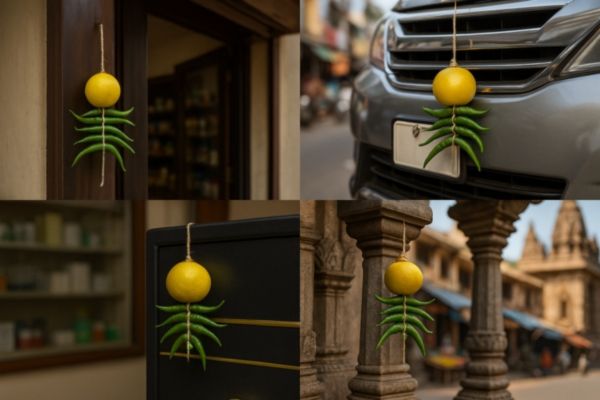
The nimbu-mirchi is a traditional charm made by stringing together one lemon and seven green chilies. It is tied with cotton thread and usually hung upside down.
You’ll most often see it:
- At the main entrance of homes and shops
- On newly purchased vehicles
- At the cash counter or near the locker in businesses
- Outside temples, roadside stalls, and even on construction sites
This charm is positioned at the threshold. The space between the outside world and your protected inner space. In Hindu belief, the doorway is a sensitive point where energies shift. The nimbu-mirchi acts as a shield, guarding that opening from negativity, jealousy, and harmful intentions.
Its appearance may be simple, but the logic behind its placement reflects an age-old understanding: that protection begins before problems enter.
Cultural and Mythological Significance

The custom of hanging nimbu mirchi is deeply rooted in Hindu tradition. It is more than a symbolic gesture. It reflects the belief that unseen energies can influence our lives, homes, and fortunes.
In Indian culture, it is believed that success, prosperity, or sudden growth often attracts jealousy and negative attention from others. This energy, known as the drishti or nazar (evil eye), is said to cause disturbances, ranging from financial loss and ill health to general misfortune. The nimbu mirchi is used as a protective barrier to keep such harmful energies at bay.
The practice also finds mention in stories from Hindu folklore. One such story involves Alakshmi, the goddess of misfortune and poverty. According to belief, she is the elder sister of Goddess Lakshmi, the deity of wealth and fortune. Alakshmi is said to be drawn to homes where wealth resides. However, she has a taste for sour and pungent food.
To keep Alakshmi from entering, people hang a string of lemon and chilies at the entrance. It is believed that she consumes the offering at the door and turns away, leaving prosperity untouched within.
This simple ritual, passed down through generations, reflects an age-old understanding of energy, intention, and protection.
Protecting Against Evil Eye (Nazar)
_201596.jpg)
In many Hindu households, the concept of the nazar or evil eye is taken seriously. It is believed that intense envy or admiration, whether intentional or not, can create a subtle force that disrupts a person’s harmony, health, or success.
The nimbu mirchi is considered a powerful tool to deflect this energy.
Its sharp combination of sour (lemon) and pungent (chilies) elements is believed to confuse or neutralize the effect of the evil eye. According to traditional belief, negative energy cannot enter a space where the vibration of protection is already active.
By placing the charm at the entrance, people create a spiritual firewall. Just as one protects the body from illness, this is a way of protecting the home or workplace from invisible threats.
While modern science may not quantify this energy, countless families across India still hang the nimbu mirchi with faith that it shields their space and keeps their blessings safe.
Symbolism Behind Lemon and Chilies

At first glance, a lemon and seven green chilies may seem like an unusual combination. But in Hindu tradition, every item used in a ritual carries a deeper symbolic meaning and the nimbu mirchi is no exception.
The lemon symbolizes sourness and cleansing. In spiritual belief, it is said to absorb negativity and disrupt lower vibrational energies that attempt to enter a protected space. The green chilies represent heat, sharpness, and the fire element. They stand for vigilance and protection, much like Agni, the Vedic purifier, which burns away impurity and harm.
Together, they form a symbolic shield of distraction and deflection, not welcoming negative forces, but disrupting their path before they enter.
The significance of this combination also connects to a lesser-known mythological belief. In Hindu folklore, Alakshmi, the elder sister of Goddess Lakshmi, is the embodiment of poverty, unrest, and misfortune. While Lakshmi blesses homes with wealth and peace, Alakshmi is said to bring conflict, hunger, and decay.
It is believed that Alakshmi has a taste for sour and pungent foods. So, when a nimbu mirchi is hung at the entrance, it is offered to her at the threshold. Satisfied by the offering, she turns away and does not enter the home. This symbolic act ensures that Alakshmi stays outside, and Lakshmi remains within.
Even the number, seven chilies and one lemon, follows traditional patterns used in Hindu rituals. Odd numbers are often used to create energetic imbalance, which is thought to disturb negative forces that thrive in symmetry and repetition.
In this way, the nimbu mirchi is not just a charm. It is a visual and energetic message to misfortune: you are not welcome here.
Scientific or Practical Perspective:

While the nimbu-mirchi is deeply rooted in spiritual and cultural beliefs, there are also practical explanations for its use that align with scientific reasoning.
Natural Pest Repellent:
Lemons and green chilies possess properties that can deter insects. The strong aroma released from the pierced lemon and chilies is believed to repel pests like mosquitoes and flies, which are common in many regions of India. Hanging them at entrances could thus serve as a natural method to keep such pests at bay.
Preservation of Food:
In earlier times, before the advent of modern refrigeration, households used natural methods to preserve food. The acidic nature of lemon and the pungency of chilies have antimicrobial properties, which might have contributed to their use in preserving food and maintaining hygiene.
Health Benefits:
Lemon is rich in vitamin C and has been traditionally used to boost immunity and combat fatigue. Chilies contain capsaicin, which has pain-relieving properties and can stimulate circulation. The combination might have been used in traditional remedies to address various ailments.
Psychological Assurance:
Beyond physical benefits, the act of hanging nimbu-mirchi might provide psychological comfort to individuals, instilling a sense of protection and well-being, which can positively influence one's mental state.
While these practical aspects provide additional layers of understanding, they complement rather than replace the spiritual significance of the nimbu-mirchi in Hindu tradition.
How and When is It Used?
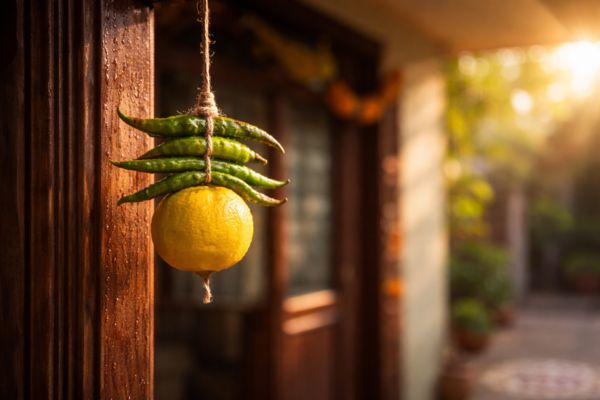
The use of nimbu mirchi follows specific customs related to its preparation, timing, and replacement. While practices vary by region, the intention remains the same, to create a protective barrier before negativity can enter.
How is it prepared and hung?

- A fresh lemon is pierced and threaded with seven green chilies, usually in a vertical line.
- Cotton or black thread is often used, with some households applying a drop of sindoor or mustard oil for added ritual value.
- The charm is always hung upside down, with the lemon at the bottom. This formation is believed to pull down and neutralize negative vibrations.
It is tied on:
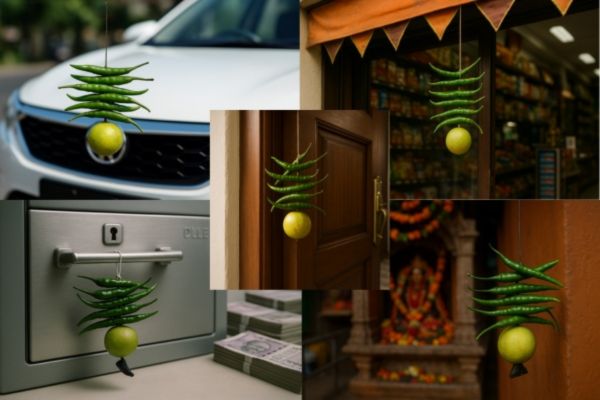
- Main entrances of homes and shops
- New vehicles
- Cash counters or lockers
- Temples or roadside stalls
Is there a ritual or mantra before hanging it?
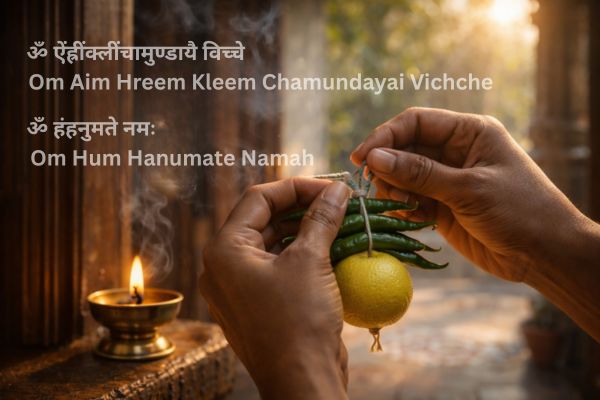
In many traditional households, a short ritual is performed before hanging the nimbu mirchi, especially if it is placed with spiritual intent. Some commonly used mantras include:
Durga Protection Mantra
ॐ ऐंह्रींक्लींचामुण्डायै विच्चे
Om Aim Hreem Kleem Chamundayai Vichche
Chanted for divine protection against unseen forces
Hanuman Mantra
ॐ हंहनुमते नमः
Om Hum Hanumate Namah
Used for strength and warding off evil eye or spirits
In certain families, a sankalpa (intention) is also taken mentally, asking for protection, peace, and prosperity, before tying the charm.
When is it placed?

Most commonly on Fridays or Saturdays.
During important lunar phases like Amavasya (new moon) or Purnima (full moon)
On auspicious beginnings, such as:
- Opening a new shop or office
- Starting a journey
- After recovering from illness or setbacks
How often is it replaced?

Generally, once a week, usually on Saturday.
In homes or businesses with higher footfall or activity, it may be replaced more frequently
The idea is not just about freshness, it’s a renewal of energetic protection
By combining simple household items with focused intention and ancient wisdom, this practice continues to be a powerful way to safeguard one's living and working space.
Regional Beliefs and Variations
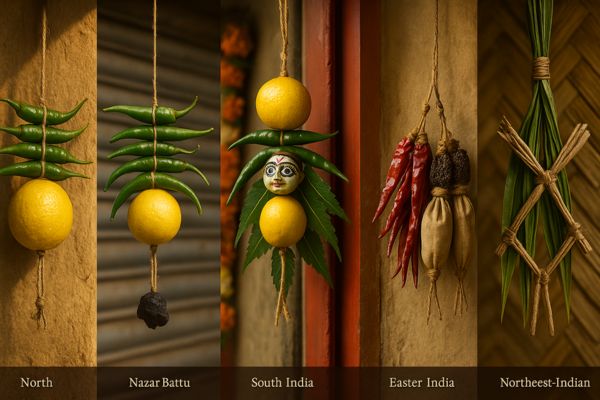
The practice of hanging nimbu mirchi is widespread across India, yet its interpretation and implementation vary across different regions. Here's an overview of how this tradition manifests uniquely in various parts of the country:
North India
In states like Uttar Pradesh and Rajasthan, nimbu mirchi is commonly hung at the entrances of homes and businesses to ward off the evil eye and bring prosperity. The combination of lemon and chilies is believed to absorb negative energy and protect inhabitants from misfortune.
Western India
In Maharashtra and Gujarat, the nimbu mirchi is often referred to as a 'nazar battu' and is prominently displayed on vehicles, shops, and homes. It's considered a protective talisman against jealousy and ill intentions. Additionally, some households incorporate a piece of charcoal at the base, believed to absorb negative energies.
Southern India
In Tamil Nadu and Karnataka, variations of this practice include hanging a combination of lemon, chilies, and sometimes even a small doll or mask at the entrance. This is intended to scare away evil spirits and protect the household. The use of turmeric and neem leaves is also prevalent in these regions, symbolizing purification and protection.
Eastern India
In West Bengal and Odisha, while the lemon-chili combination is less common, similar practices involve using other items like red chilies and mustard seeds to ward off evil. These are often tied in small cloth bundles and hung at entrances.
Northeastern India
In states like Assam and Manipur, traditional beliefs focus more on local herbs and symbols for protection. While the nimbu mirchi is not a widespread practice here, the underlying concept of guarding against negative energies remains prevalent through other regional customs.
Note: The practice of hanging nimbu mirchi is deeply rooted in cultural beliefs and varies significantly across different regions. While the core idea of protection remains consistent, the materials and methods employed reflect the rich diversity of India's cultural tapestry.
Is Hanging Nimbu Mirchi Still Relevant Today?

In a world shaped by technology, logic, and modern science, ancient customs often come under scrutiny. Yet, the tradition of hanging nimbu mirchi continues across India, not just in rural homes but also in urban spaces, offices, and commercial hubs.
So why does this practice persist?
For many, it serves as a cultural anchor. A reminder of heritage and ancestral wisdom. Rituals like these aren’t merely symbolic; they create a sense of emotional and energetic security. Even those who may not fully believe in the concept of the evil eye often follow the practice as a precaution or out of respect for tradition.
Some believe that the act of regularly changing the charm cultivates mindful awareness of protection and energy in the home or workplace. For spiritual seekers, it becomes a way to consciously mark their space with positive intention.
Moreover, in times of uncertainty, be it health, business, or personal life, such customs offer a quiet assurance that every possible step is being taken to protect what matters.
In that sense, hanging nimbu mirchi today is not about rejecting science. It is about preserving balance between faith and reason, tradition and modernity.
Modern Mindset vs. Traditional Faith
Today’s generation often looks at ancient customs with a questioning eye. “Does it really work?” “Is this just blind belief?” These are fair questions, and necessary ones. But to understand traditions like the nimbu mirchi, we must see them not just through the lens of proof, but also through the lens of purpose.
A modern mindset seeks explanations. Traditional faith focuses on intention and experience.
Hanging a lemon and chilies at the door may not have a formula you can measure, but its purpose is clear, to set a boundary, to create protection, to honour unseen forces that may influence life.
For many households, especially those rooted in spiritual living, it is not about superstition. It is about living in awareness of energy, emotions, and environment.
Interestingly, even those who claim not to “believe” often choose to follow the ritual, because it is harmless, comforting, and part of what makes their space feel protected and complete.
Rather than discarding such practices, the modern seeker is learning to look deeper asking not just “Is it true?” but “What does it teach me?”


-in-Astrology.jpg)






.jpg)



Comments 0
Leave your thought here